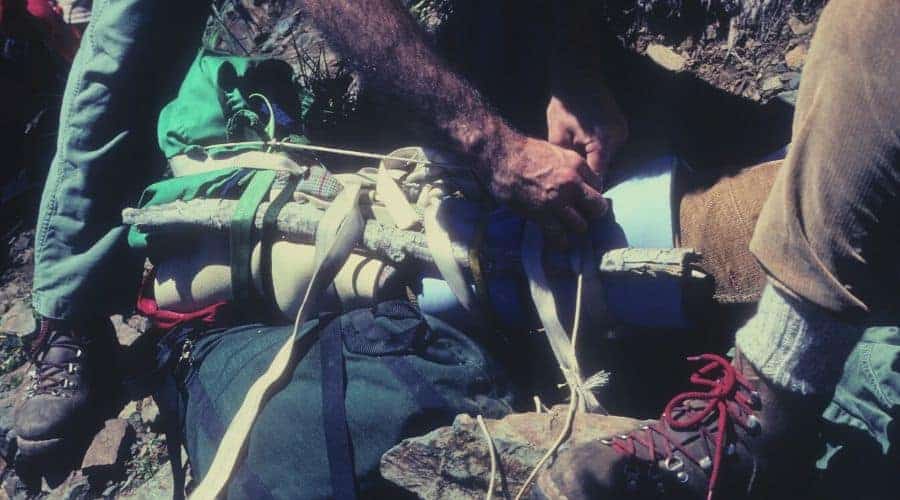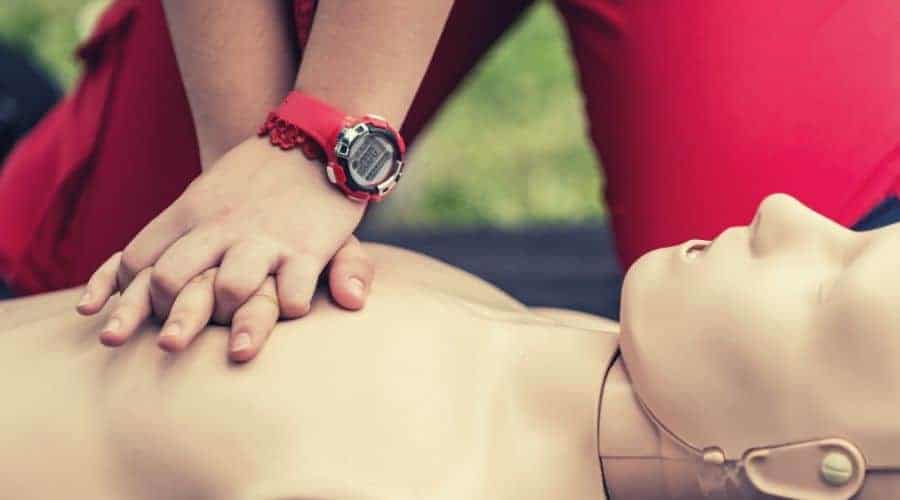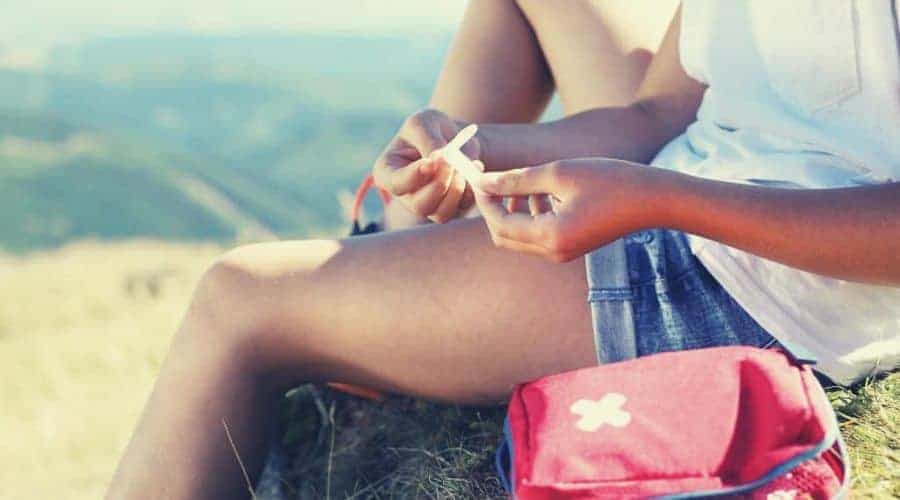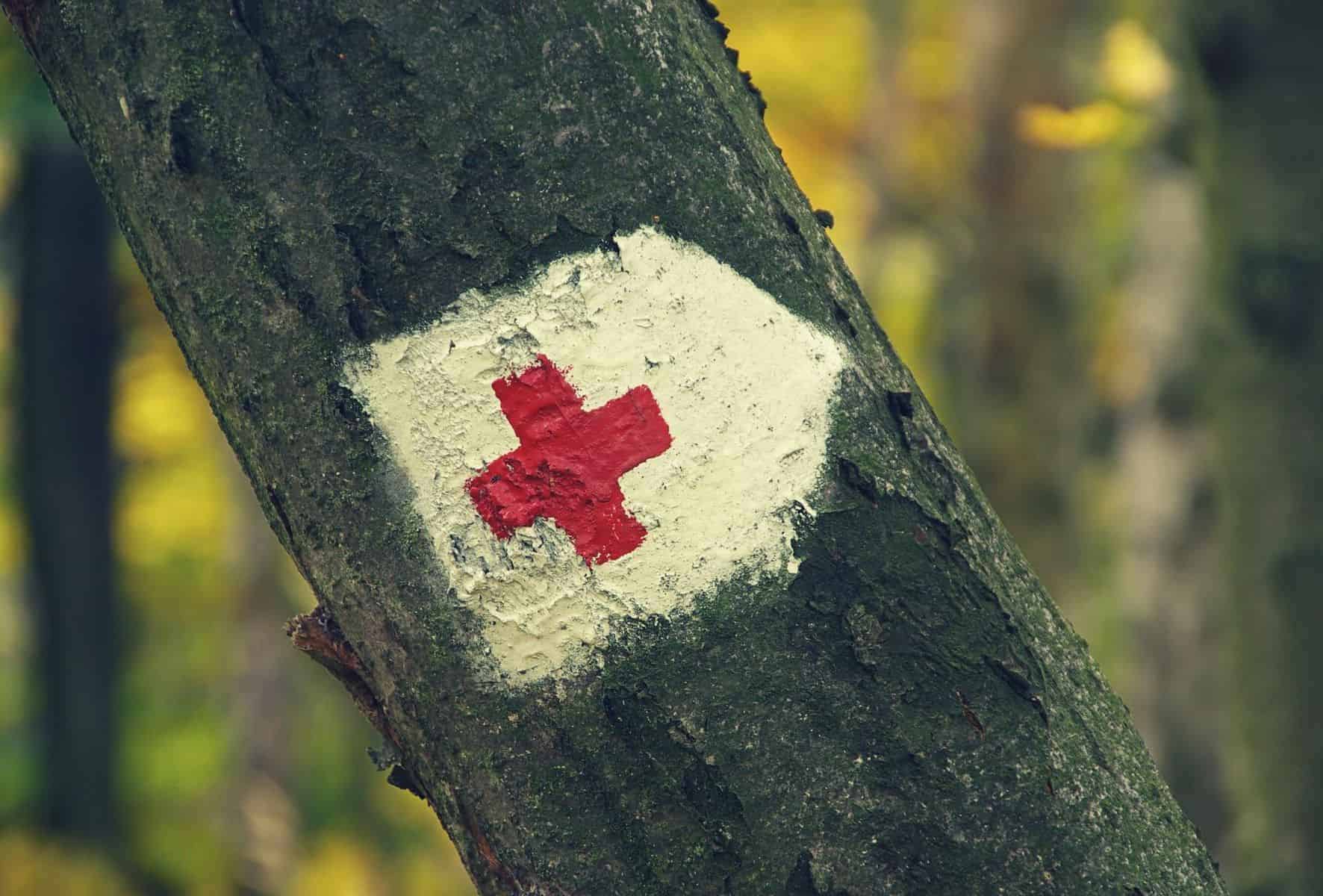Properly preparing for a backpacking trip includes packing a good first aid kit. Taking inadequate medical supplies can exacerbate ongoing health issues, complicate minor injuries, worsen allergic reactions, or escalate serious emergencies on the trail.
In this article, we look at why this often-overlooked essential should be the first thing in your backpack for every adventure. We present a comprehensive list of potential items for your first-aid kit, detailing the purpose of each item. Additionally, we offer a recommended first-aid checklist tailored for day hiking, backpacking, and camping, along with a downloadable version for convenience.
We explore the advantages of crafting a DIY wilderness first aid kit from the ground up instead of purchasing one. Additionally, we discuss using common backpacking gear items for medical purposes in emergencies, options for obtaining hiking-specific medical training, and common ailments and illnesses prevalent when hiking or backpacking.
Table of Contents
- Key Takeaways
- What should be in a first aid kit?
- How To Know What To Pack In A First Aid Kit?
- Downloadable First-Aid Kit Checklist
- What are the benefits of a DIY First Aid Kit vs Buying One?
- Can Hiking Gear Compliment Your First Aid Kit?
- Where Can You Get First-Aid Training?
- What Are The Most Common Hiking & Backpacking Ailments?
What should be in a first aid kit?
We’ve compiled a comprehensive list of items you may wish to consider when building a DIY first aid kit. Keep in mind, that this list is not exhaustive, nor are we suggesting your kit should contain every item!
The selection should be based on the size and medical requirements of your group, the duration of your camping or backpacking trips, and the conditions you are likely to encounter.
Basic Care
The following is an extensive list of items for treating common, non-life-threatening, and minor injuries.
| ITEM | DESCRIPTION & COMMON USES |
|---|---|
| Antiseptic Wipes | Necessary for disinfecting/sterilizing wounds, cuts, and scrapes. BZK based wipes are preferable for wound cleaning but alcohol-based wipes will also do the trick. |
| Assorted Adhesive Band-Aids | Varying lengths and widths to cover minor cuts to larger wounds. Fabric bandages adhere better than plastic band-aid. |
| Compound tincture of benzoin | Acts as an extra adhesive on bandaging and helps to seal cuts and wounds. |
| Triple Antibiotic Ointment | Ointments such as Neosporin, Bacitracin, Polysporin, and Germolene help to prevent infection. |
| Gauze pads (various sizes) | For cleaning wounds and applying ointments. |
| Medical adhesive tape | To secure bandages and dressings. Waterproof varieties are recommended. A ten-yard roll with a minimum 1” width should suffice. |
| Butterfly bandages | Also, known as wound closure strips, these are used to assist in the closure of small wounds and cuts. |
| Nonstick sterile pads | Protect wounds from infection and can be removed without re-opening the wound. |
| Blister treatment | Pads such as Dr. Scholl’s help to heal and prevent blisters. |
| Insect sting relief treatment | Pads or wipes that contain some form of antiseptic, analgesic, anesthetic, or antipruritic and reduce irritation and inflammation. |
| Safety pins | For securing bandages, slings, and dressings. |
| Tweezers | To remove ticks and splinters. |
| Antihistamine | To treat allergic reactions to foodstuffs, pollen, dust, animals, plants, etc. |
| Ibuprofen or other painkillers | For use in a variety of situations, ranging from headaches, toothaches, and menstrual pains to relieving pain in sprained ankles or wounds. |
Accidents
The following items are used to treat more serious injuries, such as fractures, wounds, and sprains.
| ITEM | DESCRIPTION & COMMON USES |
|---|---|
| Elastic wrap | To compress strains and sprains. |
| SAM splints | A lightweight and more versatile means of immobilizing bone and soft tissue injuries. |
| Finger Splint(s) | To immobilize and protect injured fingers. |
| Hydrogel-based pads | Protect dry or dehydrated wounds and minor burns. |
| Rolled Gauze | For wrapping wounds and other injuries. A 4”x 4-yard roll will cover longer trips and weighs next to nothing. |
| Rolled, stretch-to-conform bandages | An upgrade on rolled gauze, these allow for greater movement in injured areas such as elbow joints, knees, or fingers. |
| Cleansing pads with topical anesthetic | To clean out wounds. The anesthetic properties numb the area while you clean. |
| Hemostatic Gauze | Seals wounds more effectively than powders or creams. |
| Liquid bandage | Ideal for protecting cuts, scrapes, and wounds on areas where bandages and plasters are liable to fall off, i.e. finger joints, elbows, and knees. |
| Oval eye pads | For protecting and treating eye injuries. |
| Triangular cravat bandage | To create slings, and tourniquets to stop bleeding, and protect head and eye injuries. |
Medications
The following items include treatments for specific ailments and injuries.
| ITEM | DESCRIPTION & COMMON USES |
|---|---|
| Hand sanitizer | To sterilize hands prior to treating an open wound or cut. |
| Lubricating eye drops | To treat eye infections and injuries. More likely to be required in arid, dusty terrain and in the case of photokeratitis (snow blindness). |
| Antacids | To treat acid reflux, heartburn, indigestion, and coughs. |
| Throat lozenges | Lubricates irritated throat tissues. Particularly useful at high altitudes or in very dry or cold climates. |
| Aspirin | Can be used to treat pain, fever, inflammation, or to stop an impending heart attack. |
| Antidiarrheal pills | To treat the symptoms of diarrhea. |
| Poison ivy/poison oak treatment | Barrier creams such as IvyBlock will help to prevent developing a rash. Cortisone creams or calamine lotion will help reduce itchiness should a rash develop. |
| Antifungal foot powder | Because multiple days on the trail can turn your feet into a happy (and pungent!) breeding ground for fungi. We recommend Desenex Foot Powder. |
| Oral rehydration salts | To prevent and treat dehydration. Also useful for staving off cramps and muscle fatigue. |
| Injectable epinephrine | To treat life-threatening allergic reactions. |
| Glucose or other sugar solution | To treat hypoglycemia. |
| Aloe vera gel | To relieve sunburn, rashes, and chafing. |
| Prescription medications | Antibiotics, insulin, antidepressants, etc. |
| Ibuprofen or other painkillers | For use in a variety of situations, ranging from headaches, toothaches, and menstrual pains to relieving pain in sprained ankles or wounds. |
Supplies
This list includes non-perishable items used to assist with wound care and the treatment of injuries.
| ITEM | DESCRIPTION & COMMON USES |
|---|---|
| Waterproof container | To protect supplies and medication. |
| Medical waste bag | To dispose of used items. |
| Duct tape (small roll) | Useful for securing splints or bandages. |
| Hand warmers | A very welcome addition should one of your team develop signs of frostbite. |
| Suture needle and thread | To stitch larger wounds. |
| CPR masks | Aids resuscitation during CPR. |
| Medical gloves | For sterilization and treating someone else’s wounds (nitrile varieties are best) |
| Small mirror | To assist with eye and facial injuries. |
| Safety razor blade/scalpel | For minor field surgery. |
| Scissors (blunt tip) | For cutting dressings and remove clothing from injured areas. |
| Thermometers | A standard oral thermometer and a
low-reading thermometer to gauge fevers and hypothermia respectively. |
| Cotton-tipped swabs | For cleaning wounds or applying ointments. |
| Irrigation syringe | To irrigate and cleanse wounds (i.e. wound irrigation). An 18-gauge catheter is preferable. |
| First aid manual | Not all medical issues are straightforward, so it’s a good idea to have a first aid manual with you. |
How To Know What To Pack In A First Aid Kit?
The following checklists are designed to help you customize your first-aid medical kit based on the specific needs of your trip.
- Day hiking first-aid kit checklist
- Backpacking first-aid kit checklist
- Camping first-aid kit checklist
Day hiking first-aid kit checklist
The following list consists of essential items that every hiker should consider carrying on a day hike. These items form the core of any camping, backpacking, or hiking first aid kit.
- Aspirin
- Ibuprofen
- Antacids
- Medical tape
- Blister treatment
- Antihistamine
- Knife and scissors (or multi-tool)
- Tweezers
- Small mirror
- Elastic wrap
- Oval eye pads
- Insect sting relief treatment (hydrocortisone is best for bee stings)
- Prescription medication, ointments, and lotions
- Antibiotic ointment
- Antiseptic wipes
- Assorted adhesive bandages
- Triangular cravat bandage
- Cleansing pads with topical anesthetic
- Rolled gauze
- Bacterial ointment
- Splints (or sam splints)
- Safety pins
- Pain relief medication
- Butterfly bandages
- Hand sanitizer
- Medical waste bag
- Waterproof container
Backpacking first-aid kit Checklist
On a multi-day backpacking trip, keeping weight down is a primary concern; however, consider making sacrifices elsewhere before trimming down your first aid kit.
As with the overnight kit, you’ll need extra quantities of some supplies. The law of averages, moreover, dictates that the more time we spend outdoors the higher the risk of sustaining an injury or becoming ill. For this reason, we’d recommend adding the following items to those already on our overnight first aid kit checklist:
Additional Items
- Thermometers
- Aloe vera gel
- Oral rehydration salts
- Hemostatic Gauze
- Rolled, stretch-to-conform bandages
- Antidiarrheal tablets
- Antifungal foot powder
- SAM splints
- Finger Splints
- Suture needle and thread
- Irrigation syringe
- Throat lozenges
Extra Quantities
- Prescription medication
- Aspirin
- Ibuprofen
Camping first-aid kit checklist
The quantities needed for each first-aid kit item will depend on the size of your camping group. We recommend doubling up on the most frequently used items (adhesive bandages, aspirin, ibuprofen, insect sting relief treatment) for every four group members.
A few items to consider (in addition to those above) including in a group camping kit are:
- Injectable epinephrine
- Antihistamine
- SAM splints
- Glucose or other sugar solution
- CPR mask
- Nail file
- Fire Starter
Downloadable First-Aid Kit Checklist
We consolidated the information from the three checklists above into the single spreadsheet below. You can filter, copy, or download it as a PDF by following this LINK HERE.
What are the benefits of a DIY First Aid Kit vs Buying One?
You can opt to assemble your own first aid kit or purchase a pre-made one (check out our guide to the best backpacking first aid kits). Below, we examine the advantages and disadvantages of both.
| PROS | CONS | |
Pre-made Bought First Aid Kit |
|
|
DIY First Aid Kits |
|
|

Can Hiking Gear Compliment Your First Aid Kit?
Many gear items in your typical hiking and backpacking kit can double up as survival medical tools. Here are some common pieces of gear that can fulfill a medical function with a little know-how.
- Trekking Poles and Emergency Survival Bag. In the event of emergency services being unable to reach you and a stricken team member (or vice-versa), the following trick could be a lifesaver: Take your survival bag and cut two holes in the corners opposite the bag’s opening. Fasten two pairs of trekking poles together with tape and slide one pair through each hole. You now have an improvised but functional stretcher.
- Tent Footprint or Backpack Liners. These can be wrapped around yourself or a team member to prevent hypothermia.
- Swiss Army Knife or Multi-tool. To save carrying additional gear on our above lists, the scissors on these can be used for cutting bandages or removing clothing around a wound, and the tweezers for removing ticks.
- Trekking Poles or Ice Axe. These can be used as a makeshift splint in the case of a fracture or severe sprain.
- Water Purification Tablets. Tablets that use chlorine dioxide can be used both to sterilize water and to irrigate or cleanse a wound, helping to prevent infection.
- Suncream and Lip Balm. If you have nothing else at hand, suncream or a moisturizing lip balm can act as a reasonable lubricant or salve in areas affected by chafing.
- Towel. Your microfiber towel (depending on its size) can be used for various medical emergencies, such as a makeshift bandages or slings (see our guide to the best camp towel).
Where Can You Get First-Aid Training?
Several organizations offer first-aid training through online courses, books, and in-person sessions.
Responding to a medical emergency and learning how to use your kit takes a bit of effort. This can be done online or by reading books such as Medicine for the Outdoors: The Essential Guide to First Aid and Medical Emergency or Backcountry First Aid and Extended Care.
A better bet is to take a more hands-on approach and treat yourself to some training on a first aid course before your next adventure. First aid courses are provided by a number of organizations such as:
Buying or preparing your hiking or backpacking medical kit is not the final step, but the first. Many hikers and backpackers fall into the trap of assuming that once they’ve got everything together and safely stowed in their pack, they’re good to go, just remember for it to be effective you need to know how to use the kit.

What Are The Most Common Hiking & Backpacking Ailments?
Despite the diverse terrain, climates, seasons, and trail difficulty, hikers and backpackers commonly encounter the ailments and injuries listed below.
- Blisters. Caused by friction between your skin and the material of your boots or socks, these little nasties can be enough to ruin your trip. Blister prevention starts with a good fitting pair of hiking boots or shoes..
- Sprains. Rugged, uneven, and slippery terrain is pretty much the ideal environment for spraining a knee, wrist, or ankle.
- Cuts and abrasions. Low-hung branches, sharps rocks, slippery scree, backpack straps, and (mishandled) camping knives are just a few potential perpetrators.
- Sunburn. Lengthy exposure to the sun and/or hiking in snow-covered terrain and at altitude make hikers prime candidates for copping an excess of ultraviolet rays.
- Chafing. This occurs as a result of skin rubbing against skin or clothing and shouldn’t be underestimated as a source of tear-inspiring discomfort. (learn first aid for chafing)
- Cramp. Involuntary muscle contractions that can strike as a result of sustained muscular exertion without replenishing salts and fluids lost through perspiration.
- Tick Bites. If untreated, these can transmit Lyme Disease, an infectious disease that can result in paralysis, heart problems, and arthritis.
- Breaks and Fractures. Sustained in a number of ways, ranging from trips, slips, and falls to being hit by falling rocks or stubbing a toe on a barefoot wander around the campsite.



Great article, thank you.